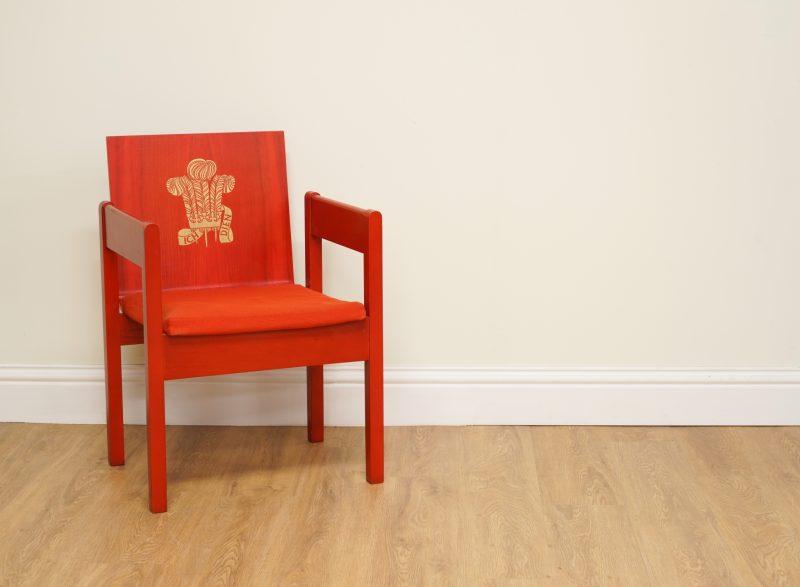On 1st July 1969 Prince Charles was formally presented the title of The Prince of Wales. Broadcast to over 500 million people worldwide just four months before his 21st birthday, the young Prince saw the ceremony as ‘a way of officially dedicating one’s life or part of one’s life to Wales’1

Held at Caernarfon Castle, the event was organised by a specially established Investiture Committee with the ceremony adapted for television by Charles’ uncle Lord Snowdon (Antony Armstrong-Jones, 1st Earl of Snowdon). His modern use of a transparent Perspex canopy above the ceremony held on a slate dias meant that mounted television cameras could bring an intimate view of the six-hour event into the homes of millions.
You are watching: HRH The Prince of Wales (now King Charles III) an Investiture Chair

For the 4,600 guests who attended the ceremony at Caernarfon Castle, these vermillion red investiture chairs were made. It was also Lord Snowdon who designed them, ensuring they were in-keeping with his modernisation of this historic and important ceremony
The technique of laminated plywood has been utilised and celebrated by modernist designers since the 1920s.[1] Finnish architect Alvar Aalto’s innovative use of the material had a significant impact on other designers meaning its use for the investiture chairs was, by the late 1960s, a modern, yet classic choice.

Read more : Antique Centres in Dorset & Somerset
Upon closer inspection, the design of the chairs as a whole become representative of a collaboration between modernism and tradition. This tradition is highlighted but the use of Welsh red flannel fabric made by David Lewis Limited of Cambrian Mills in Drefach Felindre and through the recognisable gold embossed Prince of Wales’s feathers on the backs of each chair.[1] This is then contrasted with the bright use of vermillion red staining the chairs (interestingly rain was a factor for the designers when painting the chairs, they ensured they were all sealed with a clear acid catalyst lacquer so the paint would not run onto the guest’s clothes if it rained[2]) as well as the previously mentioned modernist use of laminated plywood.

Due to their modernist, mass-produced design, after the event the chairs were marketed and sold flat-packed first to guests and then became available to the public at £12.00 each (equivalent to around £250 today). The boxes they came with are sometimes sold with the chairs and can be seen in this pair we sold here at Bellmans in 2020.

Ahead of the King’s Coronation on 6th May, it is interesting to consider the chairs that will be used in the ceremony as they have their own story to be told. At different points during the service, The King and the Queen Consort will be seated in what’s known as Chairs of Estate and Throne Chairs.[1]
The Chairs of Estate that will be used this Saturday have been adapted from chairs used in the Coronation of Queen Elizabeth II in 1953 creating a tangible connection to his Mother’s ceremony.


Read more : SOUTH MOLTON SALVAGE FAIR
For The Enthroning and the Homage, Their Majesties will be seated on chairs made for the Coronation of King George VI and Queen Elizabeth II from 1937.

One hundred sustainable British oak chairs are being made for the congregation, the blue velvet fabric on the backs and seats reminding us of the paler blue velvet used for Queen Elizabeth II Coronation stools commissioned by various High Wycombe furniture manufacturers in 1953.[1] Elizabeth II Coronation stools are always popular and many have 6 been sold at Bellmans through the years, including this example from October 2022.
Several of the frames have been made by six young graduates from The Prince’s Foundation at the Snowdon School of Furniture at Highgrove.[2] The Snowdon School of Furniture’s 12-week creative programme aims to educate and train graduate furniture design students in the value of wood as a sustainable and beautiful material for the production of design-led furniture[3]. Named in honour of furniture maker David Armstrong-Jones, 2nd Earl of Snowdon, (styled as David Linley) the son of Antony Armstrong-Jones, 1st Earl of Snowdon, who designed the Prince of Wales Investiture chairs.
Without digressing too far, it’s worth mentioning the exclusive collection of Linley furniture we have coming up for sale as part of our June Collectors’ Week at Bellmans. Lots include; A black lacquer and brass mounted pedestal desk, estimate £8,000 – £12,000, and a black lacquer and parcel lightning gilt drink’s cabinet, estimate £8,000 – £12,000.
The Prince of Wales Investiture Chair we are offering for sale this May is in great condition and comes with various accompanying paperwork including instructions explaining how to construct the chair from it’s flat-packed state, a dedicated Investiture supplement published by the Sunday Telegraph and a newspaper clipping titled ‘Investiture chairs in heavy demand.’ The chair will be lot 929 in our May Antiques and Interiors auction on 17th May, an important piece of history to be sold as The Prince of Wales ascends The Throne.

Source: https://antiquewolrd.com
Categories: Antique News

